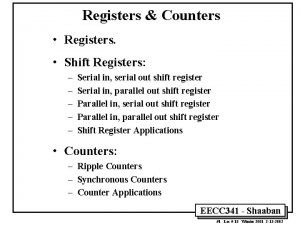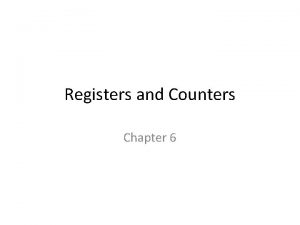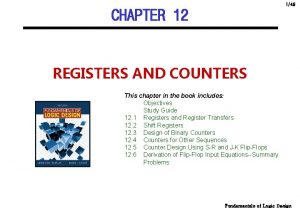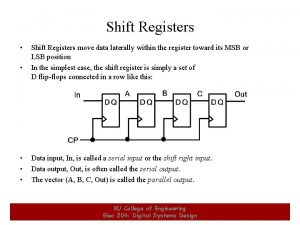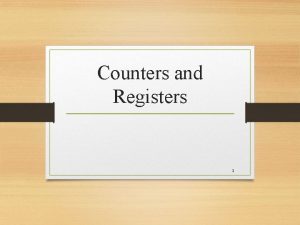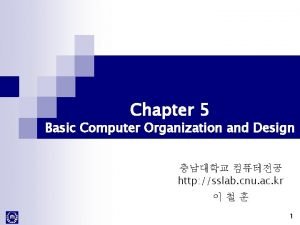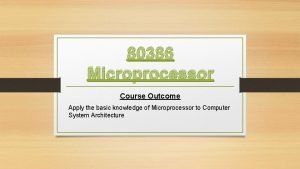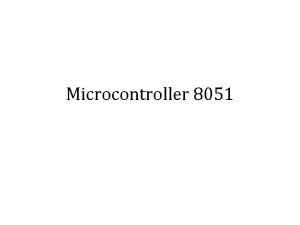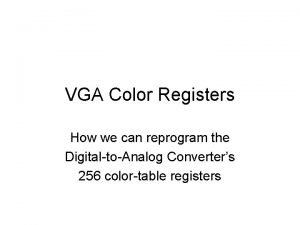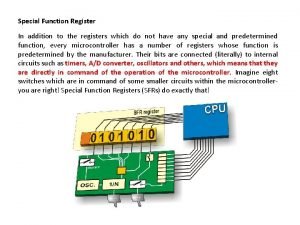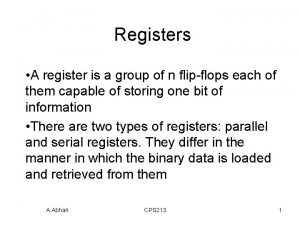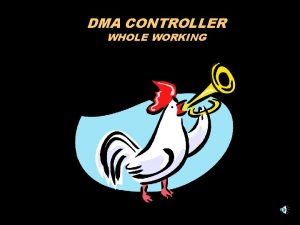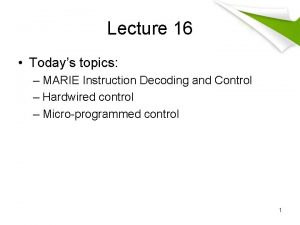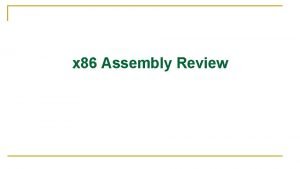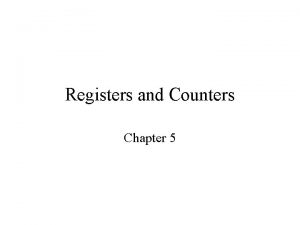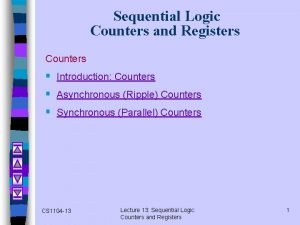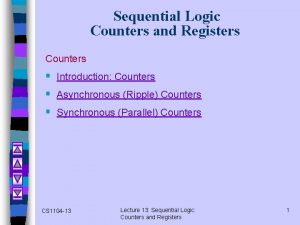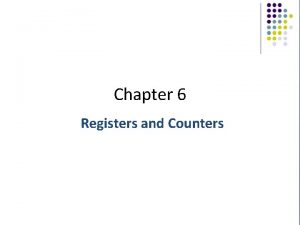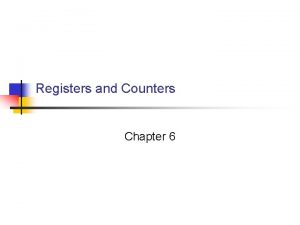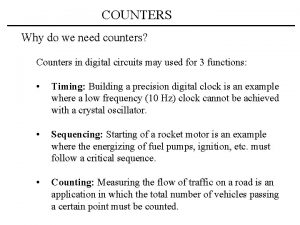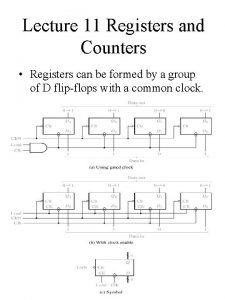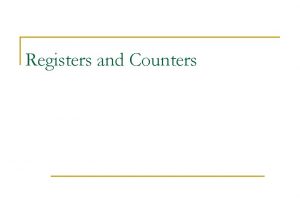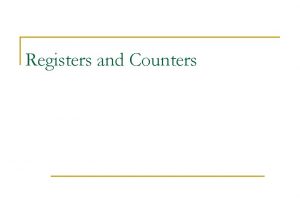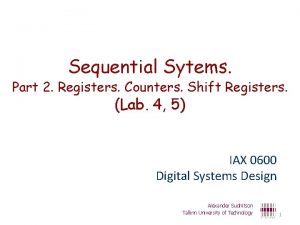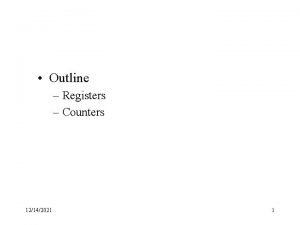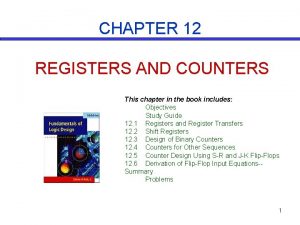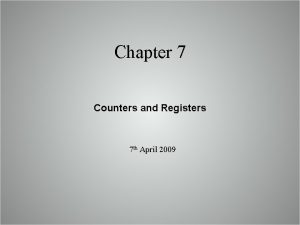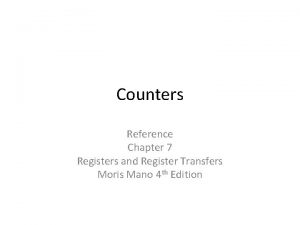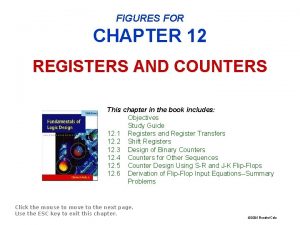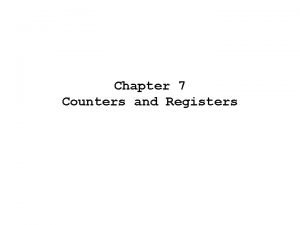Registers and Counters Chapter 6 Registers and Counters

































- Slides: 33

Registers and Counters Chapter 6

Registers and Counters • A register is a group of flip-flops • Each flip-flop stores one bit of info • A counter is a register that goes through a predetermined sequence of binary states

Registers 4 -bit register with • D Flip-flops • Common clock input • Common clear input; when Clear=0 flip-flops reset asynchronous

Register with parallel load

Shift Registers What happens with every clock pulse?

Serial transfer

Serial addition Exercise: Describe how you add two binary numbers by hand. How do you apply this to design a serial adder? Assume you have two n-bit shift registers. Design a circuit that adds one bit at a time and stores the result in one of the shift registers. How do you handle the carries? Hint: you may need one additional flip-flop. Indicate the clock connections of the shift registers and the flip-flop.

Serial adder

Serial adder

Serial adder

Universal shift register 1. Clear control to clear register to 0 2. Clock input to synchronize operations 3. Shift-right control to enable operation and associated input and output lines 4. Shift-left control to enable operation and associated input and output lines 5. Parallel-load control to enable parallel transfer and the n input lines 6. n parallel output lines 7. Control state to leave information in the register unchanged

Universal shift register Exercise: explain how this universal shift register works

Universal shift register

Universal shift register

Counters • A counter is a register that goes through a prescribed sequence of states upon the application of input pulses • Two types of counters – Ripple counters – Synchronous counters

Ripple Counters 4 -bit ripple binary counter with T Flip-flops Exercise: Obtain the state table.

Ripple counters 4 -bit binary ripple counter with D flip-flops Exercise: Explain how this counter works.

Ripple Counters

BCD ripple counter State diagram of a decimal BCD counterr

BCD ripple counter Exercise: Obtain the excitation equation and the state table. Explain how this counter works.

Three-decade decimal BCD counter

Synchronous Counters • Simple design procedure • Least significant digit Flip-flop is complemented with every clock pulse • A flip-flop in any other position is complemented when all the bits in the lower significant positions are equal to 1

Synchronous Counters Exercise: Using the excitation tables for the JK flip-flops explain how this counter works.

Up-down binary counter Countdown binary counter: • Least significant bit is complemented with each clock pulse • A bit in any other position is complemented is all lower significant bits are all equal to 0

BCD counter Flip-flop input equations are simplified using maps

Binary counter with parallel load Exercise: Explain how this counter works: • When Load is high/low; • When Clear is high/low; • When Count is high/low; • How should Load and Clear be for counting?

Binary counter with parallel load

BCD counter implemented with counter with parallel load

Other Counters Counter with unused states

Other Counters Counter with unused states

Ring counter

Johnson counter Connecting complemented LSB to ring counter input doubles the number of states of ring counter. What happens if counter starts from an unused state?

Homework Assignment • • 6. 4 6. 6 6. 9 (a) 6. 18 6. 21 6. 23 6. 26
 Counters and shift registers
Counters and shift registers Counters shift registers
Counters shift registers Registers
Registers Counters shift registers
Counters shift registers Counters shift registers
Counters shift registers Binary storage and registers
Binary storage and registers Hardware address protection with base and limit registers
Hardware address protection with base and limit registers 8051 microcontroller timers and counters
8051 microcontroller timers and counters Bb clarinet range
Bb clarinet range Vocal registers
Vocal registers Vocal registers
Vocal registers 80386 registers
80386 registers Model specific registers
Model specific registers Nhmis nigeria
Nhmis nigeria 8 bit register using d flip flop
8 bit register using d flip flop Registers in computer
Registers in computer Memory reference instruction
Memory reference instruction Write features of 80386
Write features of 80386 Fabavb
Fabavb Pc in 8051
Pc in 8051 Bris system
Bris system Vga registers programming
Vga registers programming Special function registers
Special function registers Section 4-3 check registers
Section 4-3 check registers Register
Register Offset value in microprocessor
Offset value in microprocessor Explain the command registers of 8237 dma controller.
Explain the command registers of 8237 dma controller. Instruction
Instruction Vector registers
Vector registers Ax + bx + cx + dx
Ax + bx + cx + dx Cbnl
Cbnl General purpose registers in assembly language
General purpose registers in assembly language Bris business registers interconnection system
Bris business registers interconnection system Registers of scotland customer services
Registers of scotland customer services
